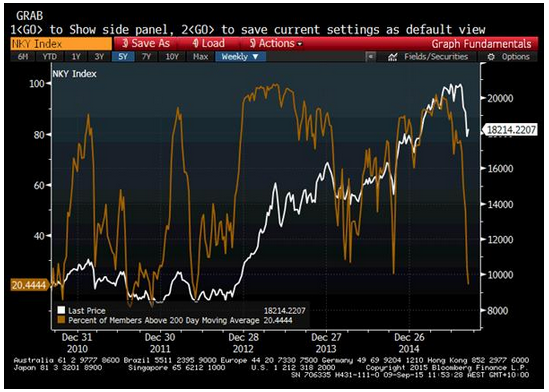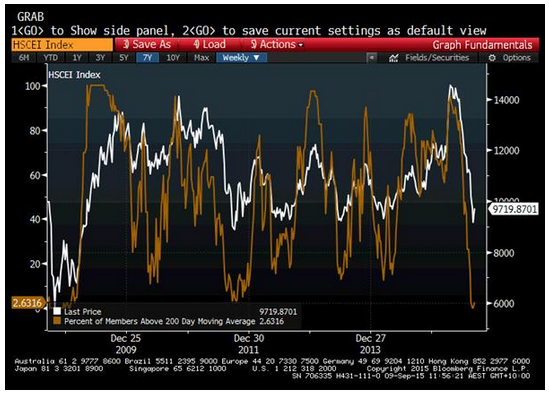Chinese markets’ ‘Sophie’s Choice’
Global markets have been buoyed by China’s new market intervention and the announcement from the China’s Ministry of Finance (MoF) that they will speed up fiscal spending. Japanese markets have been the standout performer in Asia today, seeing a record daily rise off the back of plans to cut corporate tax rates.
Having said that, the methods by which the Shanghai Composite (SHCOMP) is rising are somewhat concerning. Volumes in China’s futures markets have fallen dramatically since their reopening after the holiday for the World War II commemoration. A range of new restrictions from increased margin requirements to limits on high frequency trading (HFT) have served to throttle liquidity in the Chinese futures market.
The futures markets were previously free of some of the restrictions of China’s cash markets, such as being able to buy and sell a stock on the same day. In this way, despite having a far smaller pool of investors, it provided key signals to trading in the cash markets.
This apparently marked the Chinese futures markets as a source of volatility to be quelled. It appears China has taken a ‘Sophie’s Choice’ and decided that the futures markets must be killed in order for the cash markets to live. This appears to also be supported by some judicious buying to support the markets as well. The late session surge yesterday was driven by the large cap ‘Red Chips,’ a fairly strong indication of government buying.
This flip-flop of policies regarding support for the Chinese stock market surely has only served to further damage investor confidence in the markets, quite apart from the exact level it is trading at. It is difficult to know how this will play out going forward, or how long the government expects to continue these policies. But it is difficult to be confident of any upturn in the Shanghai Composite until it takes another trip down to at least the 2850 level.
Moves on the SHCOMP have been supported by the MoF’s statement to urge the implementation of fiscal policy. The construction and materials sector has been the best performing on the index, up 3.1%, with a number of companies perceived to benefit from increased fiscal spending trading up 10% - the inter-day limit.
Fresh fiscal stimulus is not the issue facing China in 2H, it is getting their already-promised fiscal spending targets delivered. Banks and provinces have been reticent to spend as borrowing costs have risen and credit has been difficult to come by. The main issue has been moving previously-issued local government financing vehicle (LGFV) debt onto the government’s balance sheet through the issuance of provincial bonds.
Banks baulked at the low yields on offer in the newly issued debt, and had to be forced by the government to buy them. This process has sucked up a lot of liquidity and made banks and provinces less inclined to spend. Direct intervention by the MoF and other government ministries is likely the only way to get fiscal funds flowing and meet this year’s targets.
Japan
The Japanese market has seen an impressive 5.55% rally today, its strongest one day performance since 2008. Prime Minister Shinzo Abe announced plans for dramatic cuts to corporate tax rates. He stated that he planned to initially cut the current corporate tax rate of 35% by 3.3%, and push it down into the twenties over several years until it reaches as level that compares favourably in the international context.
The market was no doubt buoyed by this news alongside renewed Chinese stock market support and fiscal spending, as well as further weakness in the yen. However, the Nikkei 225 was also partly just very oversold and primed for a rally on short covering alone. The percentage of stocks trading below their 200-day moving average had reached 20.4%, its lowest level since mid-2012.
With the temporary calm in global markets, investors were obviously seeing a good point to cover shorts or invest in stocks at knocked down valuations, particularly in high growth potential stocks. Better valuations in high growth stocks saw the healthcare sector lead the index, gaining 6.3%.

Hong Kong
The H-share market and the Hang Seng Index (HSI) have similarly seen strong gains. Trading on the HSI was buoyed by positivity in the region and also by more energy-sector related buy out announcements, as Li Ka-Shing’s Cheung Kong Infrastructure Holdings offered to buy out sister company Power Assets Holdings. Both stocks rallied more than 7% on the announcement.
But it was the H-share market that attracted the most interest, as it rose for the first time in 17 sessions. Similar to the Nikkei, the market almost could not have looked more oversold at the moment. The percentage of companies trading below their 200-day moving average in the past few weeks reached 0.2%! Its lowest level since 2009. The index was clearly primed for a short covering rally, especially as it was one of the best places to short Chinese companies listed on the Mainland.

Australia
The ASX has responded well to improved global sentiment rising 1.6%. But the real standout has been the banks, which have risen 3.4%. All of the Big Four banks have seen their stock price drop by 10% or more since August. This saw their price-to-earnings ratio drop below their long term averages. Despite concerns over refinancing needs and new capital requirements, the compelling yield available in banking stocks clearly has meant that investors are happy with the current pricing. Standing buy orders on the Big Four banks seem to be sitting around the level where they bottomed in late-August. Any return to these levels will likely re-entice buying of the stocks. The yield differential between Aussie stocks and bonds is has widened dramatically in recent times, and yield hungry investors are clearly looking to high-yield stocks to transition into.
Yesterday, Woodside (ASX:WPL) offered an all-share buyout for Oil Search (ASX:OSH) at a 13% premium to its Monday closing price. This deal is unlikely to be successful at this price, but has opened the door for Woodside to increase its offer or for other entrants to make an offer. Any successful offer for Oil Search likely would need to value it at $9.00-10.00 a share, or a 30-50% premium from its Monday closing price, which is where its share price was trading in mid-2014.
It is interesting to look at where the stocks are trading today in the wake of this announcement. OSH has largely been trading around the offer price level, clearly indicating some uncertainty over the likelihood of the deal going through. WPL’s share price has gained 1.4%, similarly indicating that investors don’t believe the deal will go through.
Fortescue (ASX:FMG) and Santos (ASX:STO) also saw solid gains in their share price today on expectations that they are planning asset sales.
There is clearly growing M&A sentiment in the energy and related sectors at the moment as we enter the lower end of the commodities cycle. It may still be a bit early to fully kick off, but quality targets are likely to be the ones most attractive to early movers. Oil Search clearly falls into this category, with its stake in the low cost and high growth potential PNG LNG Project.
If you look at some recent deals in the energy sector, you would expect any successful offer for Oil Search to be significantly higher. Shell's (NYSE:RDSa) buyout for BG Group (LONDON:BG) earlier in the year was at a 50% premium to its share price. Overnight, Canada’s Emera (TO:EMA) offered to buy Teco Energy (NYSE:TE) for a 48% premium to its share price, seeing the stock rally 25%.
A range of other entrants could be enticed to bid for Oil Search. The most obvious would be ExxonMobil (NYSE:XOM) who is its partner in the PNG LNG Project. Total, who operates the Papuan LNG project, could also potentially be enticed. Not to mention any other foreign oil companies, or energy-focussed private equity companies who could also be interested.
Oil Search has traditionally been a very highly priced company with its long term average P/E at 44.6, and P/B at 2.8. Even with the recent rally in the stock, its P/E is at 19.4 and P/B at 1.7, which clearly makes it a compelling target.
Oil Search does look like one of the most likely buyout targets in the energy sector on the ASX and, if any deal is to go through, its stock does seem likely to rise further.
Ahead of the European open we are calling the FTSE 6215 +132, DAX 10421 +373, CAC 4657 +103, IBEX 10000 +62 and MIB 22248 +636
